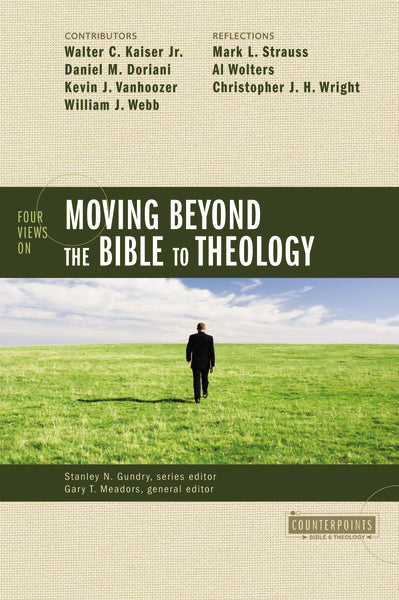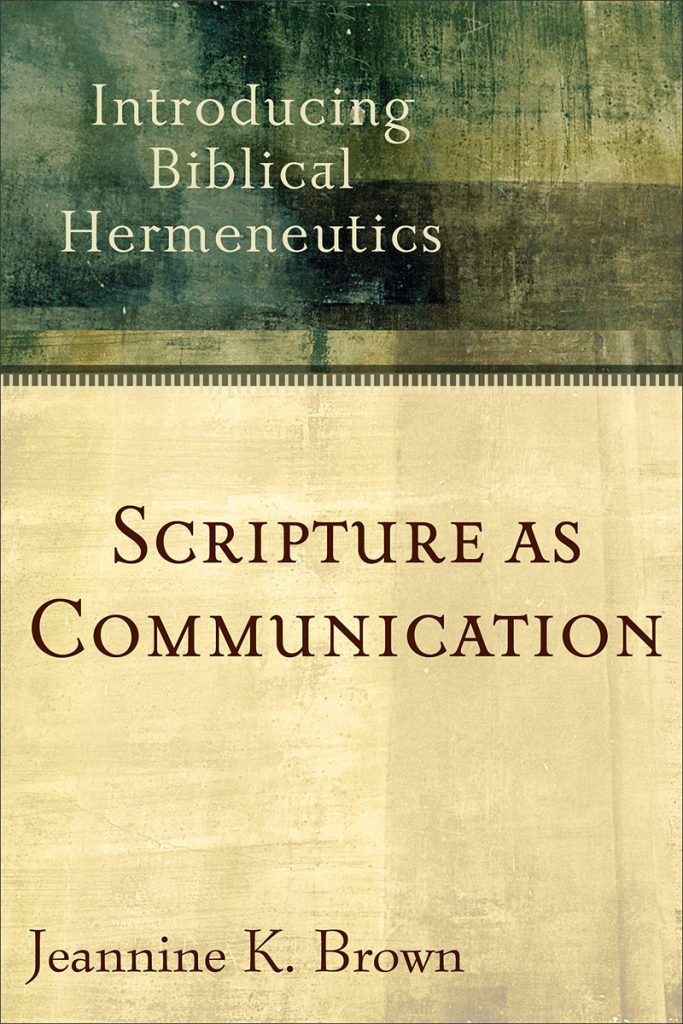As I begin the book Four Views on Moving Beyond the Bible to Theology, the first of four proposed models involves what it takes to transition study, research, and inquiry from the Bible to the origination of theological interest and tentative conclusions about God and His created order. While the Bible remains the authority and the source of all Truth, it is of significant interest to develop and understand facts, conditions, circumstances, and doctrines around the theological reality surrounding all of God’s created order. The authors of this book offer perspectives about the processes in which the bridge to theology is advocated. Applied for meaningful value while subordinate to established doctrines of the faith, areas of theological development are endless. With divine revelation through Scripture and all truth that belongs to God as observed within Creation, there are innumerable ways in which He is sought.
The Principlizing Model
The book’s first section involves a Principlizing Model (PM) that Walter C. Kaiser Jr. presented as a method of forming Scriptural principles to help to resolve modern and social questions from a theistic perspective. The inference that biblical exegesis provides a way to social utility and the betterment of humanity is welcomed to an extent, but to call that a theological outcome runs counter to what it is by definition. I agree with much of Dr. Kaiser’s assertions and conclusions about the methods of principlizing and the resolutions to the social, historical, and cultural offered from a biblical perspective. However, I would not call those outcomes or the process of arriving at various conclusions doing theology. The book’s intended purpose is to move beyond the Bible to theology. And Dr. Kaiser’s approach doesn’t get the reader there, which means that theological principles are not attempted by the PM to recognize and understand further truth.
The substance of Dr. Kaiser’s PM and its process involves a three-step generalization method that derives principles founded upon the Bible. He offers three steps of principlizing to further elaborate upon what it is and how it functions:
- Get the big idea of the passage
Identify the subject, emphasis, and interconnectivity to passages and references elsewhere to substantiate the primary point of the text under consideration. - Identify propositional concerns
From the prose, scene, or strophe, derive meaning applicable to the interpreter by use of first-person or plural pronouns to evoke potential suitability or application coherent with the biblical writers’ proper hermeneutical method and intent. - Personalize the passage
Use language in an active sense and direct action toward future tense imperatives to lead the reader into the present and put the matter into practice.
In contrast to this process of principlizing, Kaiser introduces a “Ladder of Abstraction” method of understanding both specific and general subject matter. The ladder of abstraction is usually a powerful tool for writers who create meaningful subject matter around fictional or nonfictional content, but Kaiser calls attention to it in his essay. To originate principles from concrete meaning from the first century and long before to those who wish to generalize and then substantiate specific and concrete meaning today. The idea of a ladder of abstraction is generally understood as bringing out meaning from low levels of specificity to high levels of generality and back again toward specificity within a current or modern context.
While Kaiser doesn’t offer added detail about the ladder of abstraction in his essay, it does appear in other written work he has produced. As I wrote about earlier concerns about the social utility of interpretive principles for practical use (aside from theological formation), he wrote again of going “beyond the Bible” to get answers to modern ethical questions. He casts this proposition as a “theological framework for ethics of the Bible.”1In this monograph, Kaiser elaborates further on the “Ladder of Abstraction” to show how principlization functions. While he uses case law to illustrate an example of its use, there is value in the point of what it does. Specific circumstances, messages, or stories in the Bible move from specific situations up the ladder to arrive at general principles about norms. The ladder is then descended where a similar situation applies to a contemporary rationale or set of circumstances—ascending and descending the ladder of abstraction yields questions about general situations that may correspond to similar situations or notions of inquiry to produce theological subject matter.
To further explain what Dr. Kaiser was getting at, it occurs to me there is merit in the ladder of abstraction. Not just as a writing instrument of value but to aid in biblical interpretation, according to authorial intent, where theological principles are generally and specifically derived. For example, consider a passage from A Tale of Two Cities by Charles Dickens.
“It was the best of times, it was the worst of times, it was the age of wisdom, it was the age of foolishness, it was the epoch of belief, it was the epoch of incredulity, it was the season of light, it was the season of darkness, it was the spring of hope, it was the winter of despair.”
From generality to specificity, there is the substance of meaning and tension between each contrasting point. The points made draw the reader in to ask questions and investigate what happened and what other supporting passages might add further depth to illuminate specific theological principles applicable today. Just as well, there are literary realities conveyed in Scripture that bear out theological truths that reveal God’s intended messaging.
The Redemptive Historical Model
Chapter two of Four Views on Moving Beyond the Bible to Theology transitions to the Redemptive-Historical Model, where the task of the redemptive-historical theologian (RHT) interprets Scripture from a grammatical-historical approach. Involving sound exegetical interpretation through the intended meaning of Scripture, the hermeneutic of the RHT, according to Daniel M. Doriani, is centered around Reformed tradition. Still, his essay is written in the same orientation as that of Kaiser. That is, what it means to go beyond the sacred page to faith and practice from inferring or surmising that meaning is derived from the context of humanity’s interests. As compared to the messaging about theological principles about who God is, what He has done, what He is doing, and what spiritual and technical realities exist to inform people how we should believe and behave, there remains a pressing need to set a course toward lives that glorify God and love everyone through theological reason and understanding beyond the sacred page, tradition, and confessional obligations.
Scripture, as the closed canon of God’s Word, has been of immeasurable value through the centuries. From when it originated to where it goes through contemporary contexts (regardless of geography or ethnicity), it is the bedrock of all truth from which further theological understanding is derived. The book’s title, Four Views on Moving Beyond the Bible to Theology, does not accurately describe what the book holds itself out to be. The book is not a text about how theological doctrine or systematics are historically or presently derived from understanding the study of God. Whether Biblical, Historical, Systematic, Philosophical, Practical theology, or some overlapping combination, the convergence of these areas of thought, research, and discovery should center around revelation and a progressive understanding of God from various approaches unencumbered by what we can get out of it for consumption that goes nowhere. The RHT and theologians of all stripes would do well to apply sound hermeneutical methods around literary realities, OT, NT, and intertestamental beliefs. The Ancient Near East context by which divine revelation is situated influences spiritual concerns which have a bearing on the physical and spiritual realms that intersect. The written essays from this book concerning redemptive history offer the fruit of theology for the picking, but it should be asked, “redemptive history” from what? Or that does what? The substantive formation of theological thought and understanding that produces doctrine is not a closed endeavor. For example, from underlying literary analysis alone from a second temple period or ANE perspective, there are theological truths from revelation throughout history that together form a composite of new and better-informed questions that puts weight upon what it means to fulfill all of what Jesus spoke.
While the purpose of theology isn’t an end to itself, it isn’t to be forged as an instrument directed to humanity’s interests separate from what God revealed through Creation and His Word that informs us about His Kingdom and intentions. Best I can tell, I understand and agree with everything Doriani wrote. Yet, he also wrote about the social implications of what it means to go beyond the Bible as “theology.” Of course, Scripture has much to say to us about gambling, women, slavery, ministry roles, and so much more about cultural and social entanglements today. Of course, we understand the given specifics and principles to draw from as made evident to acknowledge and accept. Still, I am persuaded that there is value in moving “Beyond the Bible” insofar as what Scripture reveals and supports by proper interpretive rationale. Doriani offers four steps about the origination of accurate interpretation, synthesis of biblical data, and the application of Scripture as the obvious rudimentary utility to what we learn and understand. However, there is a richer and deeper meaning beyond the sacred page that helps to develop a more thorough understanding of doctrines and theological interests without betraying our commitment to the sufficiency of Scripture for faith and practice. The theology of divine revelation isn’t merely narrowed to what confessional statements prescribe. It isn’t desiccated by what juice we can siphon from it. So my response to Doriani and the others through the remainder of the book is about theology proper, and not all forms of its study that converges on a pragmatic approach to practical theology. Read Jeremiah 33:3, settle upon it for a few minutes, then reread it to see what God meant by the “unsearchable” in context to what the prophet meant.
This is where I understand that theology is meant to go as it is studied through human effort. From what it accomplishes, how can we not act upon what we are shown through revelation? That’s painfully obvious. We are wading through the disputes and interactions of people who interact from different and, at times, contentious perspectives (i.e., Doriani, a complementarian, and Webb, an egalitarian). All to arrive at personal conclusions about contested positions. Not so helpful when God’s Word is explicitly clear about social and ethical expectations from the authority of Scripture. Webb’s views are pick-and-choose and easily refuted by an abundance of reasons to conclude what God revealed and intended in His Word. Yet, not as a contrary and static expression of meaning (Webb’s mischaracterization of Doriani and the RHT).
Webb offers various unsubstantiated perspectives about the merits of Doriani’s model but doesn’t refute them on their merits. Instead, Webb advocates an indirect liberation theology as a pick-and-choose garden of social justice grievance fruit to a Scriptural basket. Webb’s objections are not to Doriani but to what the Bible plainly says. To Webb, Scripture is for humanity to claim in its image as modern life recklessly requires (progressivism) and not for God and humanity described by a redemptive-historical model Doriani articulates. Because Webb is egalitarian, it is demonstrated that he does not accept the full authority of Scripture (contrary to what he claims), and he rejects the redemptive-historical model. Webb chooses a partial view of Scriptural authority with a worrisome weak grip on other revelatory facts with authority about cultures today.
Like the claims of Liberation Theology advocates, Webb would presumably find a way in Scripture to advocate a social theology that extends to a corresponding modernist worldview. Consequently, by inference, Scripture and its relevance to advancing society will eventually become further diluted in its relevance until rendered obsolete or entirely subjective. To this rationale, we can ask, “did God really say” (Gen 3:1)? Then conclude that it is okay to eat the fruit after all. Or, instead, do we consider God’s warning as the fodder of particularities and contemplation about its relevance and what He really meant so long as we get to consume the fruit? Whether metaphorical or not, the implied meaning of the garden remains the same.
The redemptive-historical model that Doriani wrote about has significant weight regarding what Scripture is and does. Doriani is faithful to proper exegetics and hermeneutics as he proposes and defends the redemptive-historical model. He offers specific steps in which a theologian can go beyond the sacred page without going against it. With constructive arcs and trajectories of Scripture and literary (“narrative”) considerations, the author proposes that RHTs can ask questions to arrive at conclusions along a path of faith and reason. Including casuistry to understand general rules and principles about moral behaviors that govern specific ethical issues.
The Drama-of-Redemption Model
Chapter three of Four Views on Moving Beyond the Bible to Theology transitions to the Drama-of-Redemption Model (DoR). Over the course of 60-pages of reading, Dr. Kevin J. Vanhoozer develops a manner in which going beyond the Bible is an active and participative approach toward understanding and living theology. He introduces the notion of theological reasoning as a Theodrama. More aptly, Theology is the shadow cast by the theodrama set in place by God’s doing. Where the Bible is Holy Script, theology is the program, and doctrine is the direction in which God’s story advances. Doctrines derived from the theological development of holy script guide participants along the fulfillment of what God has purposed from His interests. Numerous questions are answered in anticipation of expectations around order, reason, causality, instructions, place, plot, redemption, polemic, and context. Depth of understanding and situational awareness arises about the Writer and Producer who originated the story that defines who and what people are. As Vanhoozer intimated, “Theology is God-centered biblical interpretation that issues in performance knowledge on the world stage to the glory of God.” For this reason, I believe that Vanhoozer’s proposition is exactly correct and definitively makes a case for the DoR model.
Finally, someone in this book has a closer bearing on the purpose of doctrine and theology from a perspective that originates from divine revelation and not solely by interpreting it for personal or social interests (correct or not). In their response to Vanhoozer, both Kaiser and Webb appeal to what traction, utility, and tone are attained as he forms an intrapersonal allegory about what God has done and is doing during the entire redemptive story. As theology is both rooted in divine revelation and interwoven throughout sacra pagina (holy scripture), sacra doctrina (holy teaching), and sacra vita (holy living), it exists to develop a theodramatic understanding of God’s speech-act in the world and what people must do in response. As theatrical systems and designs, theology is formed to serve, worship, and do God’s will as participants in the story of redemption. As Vanhoozer put it, the story’s play is “doing the truth while in the midst of Babylon.” It is an outcome and not a matter of continuous points of scriptural extraction to accomplish what redemption means to a person or society with its own ideas of what redemption or theological imperatives mean. The theodrama is God’s story and we are participants. This is not our story. This story is for His glory, and we are the recipients of His grace, mercy, and love. We are objects, or better, persons, of His love that satisfies the rightful order of Creation as it was and is intended.
Riding the theological raft of holy script, we go beyond the Bible to do what it says. Christ Jesus’ parable of the sower clearly punctuates why it is necessary to get beyond theory and understanding (Matt 13:14-15, 18-23). Faith, practice, individual sanctification, and biblical justice are the outgrowth of living (sacra vita) theodramatic order as formed through the Bible (sacra pagina) and communicated (sacra doctrina). To jump right from human-centered predilections of interpretation, where rightful living is in the image of the interpretive activist, is to miss the precision and meaning of worship, service, and roles within the theodramatic production as described and specified by sacra pagina and sacra doctrina. There can be no Christ-centered unity without truth. Partial truth is partial unity. And unity with Holy Spirit produces work within a person receptive to Scripture who bears fruit. To walk by the Spirit is to present oneself to God as one approved, a worker who correctly handles the word of truth (2 Tim 2:15).
In this way, Vanhoozer points out that proper and effective theological understanding is performative. Scripture implies the ideal reader drawn into the reading to live the text as an active participant of the theodrama. Knowing how to act within the theological construct of the theodrama is faithful improvisation; the process of acting both spontaneously and fittingly comes through spiritual formation and discernment. Faithful adherence to the intended meaning of Scripture includes an honest recognition of the real world as compared to the world as a stage of redemptive history. The already and not yet themes of Christ throughout Scripture, from Creation to the final scene of the theodramatic story, is the reason for the biblical genre. Telling the theodramatic story through modes of translation, modulation, and resonance produces insight and awareness guided by the Holy Spirit to work out roles (Eph 2:10) within existence as it really is. Not how it is defined and understood purely through tradition, a magisterium, or siloed and ecumenically held secular interests. Existence as a world of reality that stands in witness to the theodrama is told by a story of genre for the fulfillment of redemptive drama unfolding before everyone.
The comparative and propositional models the authors advocated originate from the perspective of the reader as a person who has salvific and social interests in a subset of theology beyond the Bible. While the perspectives of God and His created beings are not necessarily mutually exclusive, humanity on the world stage is inherently subordinate. It is necessary to be in unison with the Spirit to the extent possible to understand divine intent revealed through the pages of Scripture. as Vanhoozer wrote, to know God and love God is to live as persons whose hearts, minds, and minds are captive to the Word. This is what it is to embody the gospel in new contexts as a theology that originates from what God does as a speech act. Ever learning without arriving at the knowledge of the truth (2 Tim 3:7) is what it means to attain a form of godliness while denying its power. Increasingly becoming informed without the Spirit in the theodrama of living the text, is to live out of step with the participative roles we perform. Walking by the Spirit is in step with the Spirit according to the divine intention as proposed by Vanhoozer’s dramatic redemptive approach to moving beyond the Bible to theology.
Vanhoozer further elaborates, “the Bible trains us to see things not simply from the perspective of eternity (sub specie aeternitatis) but from the perspective of the theodrama (sub specie theodramatis)” to drive home his propositional model. The DoR is a framework for persons in step with the Spirit to understand and perform by faith and grace the living Word. For purposes of redemption, placed into a theodramatic creative endeavor, people are reconciled to God, where His kingdom is formed. People are brought to God through Christ Jesus, and His redemptive work is a creative expression of passion on the world scene as it really is both physically and spiritually. In contrast to an upside-down unitary perspective cast in a historical light for principled utility, the DoR goes beyond the limited dimensions of human reason.
The Redemptive-Movement Model
Chapter Four of Four Views on Moving Beyond the Bible to Theology transitions to the Redemptive-Movement (RM) model. Dr. William J. Webb develops a manner in which going beyond the Bible is more of a social endeavor. The hard-to-read words of the Bible are set against modern sensibilities about justice and common themes about liberal interests with ecclesiological concerns involving interpretation. The reading has much to do with Webb’s prior work concerning slavery, corporal punishment, women, and sexuality. He is sensitive to how readers within contemporary society would read slavery, corporal punishment, and war passages within the Bible. In his essay, he wrote about a way of interpreting the Word along transitional cultural conditions that move across time toward criteria of social acceptability and justice on its terms. As incidents, periods, and conditions of human cruelty within the Bible bring upon the modern reader objections and grievances about what it conveys, there are contentious objections that Webb attempts to assuage by offering his RM model toward the development of modern theology.
The way Webb writes indicates he is a conscientious and compassionate person who is interested in people’s well-being. And he appears to sympathize with the victims of those wronged throughout history and today. Whether slaves, women, children, and the sexually divergent, he doesn’t want to see false beliefs and behaviors perpetuated upon the oppressed, victimized, and abused. In his essay, he doesn’t specifically elaborate upon why he has developed the RM model from selected passages to advance the cause of faith in the direction of human interest. One could surmise that he wants to see human suffering eased, whether from the outright harmful actions of others or by distress or animus that readers of Scripture might bear.
Rather than a hermeneutic of surrender to the intended, inspired, and authoritative meaning of the original texts to develop people’s hearts around biblical redemption, Webb further raises contradictions around the coherent interpretations of biblical writers. The New Testament’s use of the Old offers numerous examples of fulfilled promises, redeemed people, and themes of rescue, relief, freedom, healing, and forgiveness that deepens a robust and proper understanding of what God has done through the patriarchs, poets, prophets, and apostles. Moreover, the incarnate Christ entered the world fraught with conditions far worse than what displeases Webb. The New Testament writers who interpreted the Old Testament as divine revelation further unfolded didn’t sit upon the plight and liberation of people such as the Israelites who were oppressed throughout the Greco-Roman empire. Jesus didn’t come to rescue people from the Romans or people’s oppressors. He came to set people free from sin and spiritual oppression that will always plague all humanity—redemption from the effects of sin and its corresponding condemnation that results in death is what Jesus accomplished. There is no greater oppressor or abuser than the self enslaved and held captive to sin.
The point isn’t to suggest that society’s oppression is mutually exclusive from the ravages of sin. If what it takes to accept moral decay from liberal preferences in denial of the Word is an exchange of biblical truth and the intended redemptive message of spiritual rescue, there will be no surrender of that sort. Liberal advocates to the contrary, who have succumbed to grievance hermeneutic, would instead place the redemptive message of Scripture they understand subordinate to the interests of liberal activists who want to dismantle patriarchy, give voice to the marginalized immoral, and spread far a comprehensive “restorative justice” among those of continued lawless conduct. Society, governments, and human development can never replace God’s redemptive work through Christ. The State and people can ease suffering and support a more just society, and rightfully so, but never to the extent that biblical truth is sacrificed or redefined around deceptive changes in meaning.
In Psalm 82:1-8, God’s concern for the weak and needy is evident to readers. The afflicted and destitute treated unjustly brought judgment upon the elohim (Eph 6:12) responsible for the care and attention of the oppressed. The afflicted, fatherless, and destitute were abused, neglected, and oppressed by the “hand” of the wicked, as elohim (Deut 32:8) did not attend to them as justly governed while they were set over scattered humanity (Gen 11:8, Deut 32:7-9). When God disinherited the nations during the Babel event, they were set under the spiritual rulers (Eph 6:12) responsible for the governance of the people. These rulers were eventually condemned to “die like men” (Ps 82:7) because they would not deliver or ease the suffering afflicted by the wicked. Until the fallen rulers (spiritual powers/angels) were condemned because they did not obey (1 Pet 3:18-22, 2 Pet 2:4), the world was further captive to the control of entities hostile to God. Those among the nations who would later become drawn to God through the Mosaic law of Israel as a kingdom of priests would eventually become free of oppression, suffering, and affliction through judgment and the promised Messiah. Only how deliverance was produced wasn’t to the expectations of God’s people as a correlation to today’s liberation theology. Deliverance was produced in the reclamation of the nations and by the deliverance of each person captive to sin, both physically and spiritually.
Webb’s essay was a written work of progressive activism that comes from liberal ideology. Whether he realizes it or not, the decay of moral and social order is the effect of it, as carefully concluded by Vanhoozer. Webb’s essay was political and around the theology of liberation adherents who have his ear. Furthermore, what Vatican II was to cede to the pressures of modernity, is what Webb and Kaiser were to modern epistemology. To “bridge the ugly ditch between the Bible and the Englightenment separation,” they’re both stuck on the flypaper of modern epistemology, as Vanhoozer puts it.
I agree with nearly all the counterpoint perspectives that Vanhoozer articulates. For example, in Vanhoozer’s words, “he (Webb) does provide them with examples of how to “trump” the specific things the Bible says by identifying redemptive movement and then plotting its logical trajectory.” Webb is the author of Slaves, Women & Homosexuals: Exploring the Hermeneutics of Cultural Analysis with a charitable forward by Darrell Bock.
“In essentials unity, in non-essentials liberty, in all things charity.”
– Meldenius
While Vanhoozer, on the one hand, acknowledges the importance of sharing a place in the Kingdom with Webb while occupying a different theological foxhole, on the other hand, he was disturbed by Webb’s perspective and the implications of his “Redemptive Movement” model. As if it is offered a viable way of going beyond the sacred page to develop a more palatable way of interpreting the Bible for modern social interests. In contrast, I am reminded of what Spurgeon said long ago.
“To pursue union at the expense of truth is treason to the Lord Jesus.”
–Spurgeon., The Sword and Trowel, October 1887, p. 558
Given the popularity of cultural Marxism within evangelicalism, Webb’s views accord with those who advance against Truth as a sort of Thermopylae upon the Kingdom. Webb appears oblivious to the theodicy of sovereign intent all the way from the garden to the eschaton.
How would Webb rally modern thought to form theology beyond the sacred page with these questions?
- On corporal punishment, how could Jesus use the whip against money changers in the temple?
- On women and slaves, the womb is a brutal theater of Islamic Jihad in war and conquest.
“My Kingdom is not of this world.”
– Jesus, Jn 18:36
While I thoroughly read and understood Webb’s essay as illustrated, I just don’t accept the use of the model to undermine the whole redemptive message as intended through the human condition, the covenants, and the gospel. Where the Redemptive Movement (RM) model goes is about social ethics as people wish to claim civil liberties around lifestyles, divergent sexual practices, and a myriad of growing gender identities. This is the stuff by which God has permitted devastating and long-lasting consequences.
Let’s move toward biblical justice and compassion without diluting the plain sense of the Word with the authority and inspiration that goes with it. Going beyond the sacred page doesn’t mean we get to form a modernist apologetic for special interests with valid grievances. Going beyond the sacred page to Theology is both a vertical (Kingdom) and horizontal (missional) endeavor.
Pray then like this:
“Our Father in heaven,
hallowed be your name.
Your kingdom come,
your will be done, on earth as it is in heaven.”
– Matt 6:9-10
The Redemptive-Movement model successively moves people incrementally away from the true meaning and work of Christ Jesus right back into the camp of the oppressors (or keeps them there) as readers of the Word are more interested in how to make displeasing Scripture more progressively and culturally palatable today. Because where there is one grievance to resolve, there will surely be others as resentments, objections, or impediments to the gospel as society remains governed by the “prince of the power of the air” (Eph 2:2, Jn 8:44). The perpetual burden of progressivism cycles through what it deems correct in its own image. The beauty, depravity, splendor, and evil of humanity are captured by it through its arguments, appeals, and actions contrary to the missional work of the Kingdom.
I want to be careful here because God has high expectations about the necessity of human justice as the formation of theology develops through His word as divine revelation with redemptive specifics and themes. Pleading the cause of the widow and the orphan is necessary. Poverty relief is necessary. Slavery is unacceptable, as is child abuse. What is worse is to hijack the gospel and the true meaning of redemptive intent (including biblical justice) in an effort to leverage it for immoral individual “freedoms” and evil social outcomes. The nations are reclaimed through the biblical gospel of Christ Jesus as the Messiah to Jews and Gentiles who populate the Kingdom of God on Earth. Webb’s illustration about the absence of a “redemptive spirit” of the biblical text doesn’t mean Scripture is regressive among believers today.
“An unregenerate heart lies at the bottom of modern thought.”
-Spurgeon
Contrary to Webb’s perspective, the absence of social progressivism isn’t regressive or antithetical to an “ultimate ethic” that he says is reflected in the spirit of the biblical text. He illustrates the standard by which a social or personal ethic is situated in Culture today (as if Culture has authority and not the Word). In Webb’s words, the Bible consists of concrete words that inform readers of an ethic “frozen in time.” Suppose Webb’s RM model was a movement toward the Kingdom as a missional emphasis that involved policy and State governance in spiritual subjection to God’s biblical interests. In that case, his model could make a substantial difference in people’s lives with specific attention to relief areas with redemptive intent while within a moral framework without compromising the plain sense of the biblical text. I would recommend Webb retool his RM model away from progressivism to place it within a family of interpretive approaches to going beyond the sacred page.
Reflections on Moving Beyond the Bible to Theology
Chapter Five of Four Views on Moving Beyond the Bible to Theology transitions to the reflections of three additional contributors who offer their perspectives about the four views. The contributors were Mark L. Strauss, PhD., Al Wolters, PhD., and Christopher J.H. Wright, Ph.D., who offered reviews of selected perspectives among the four. Their assessments of the four views were about how they could offer further opinions concerning the interpretive models discussed between Kaiser, Doriani, Vanhoozer, and Webb. These opinions were set up as reflections as the reviewers wrote separate essays within their individual framework of thought. At the same time, maintaining coherence about the subject matter, each of the three contributors structured their responses according to their freedom of interest to ascertain each model’s particular strengths and weaknesses.
With the first assessment, Strauss engages two models as a hermeneutic (Kaiser and Webb), not as a method or interest in “going beyond the sacred page.” In the other two, Strauss engages the propositional models on their terms (Doriani and Vanhoozer). Through the course of observations that Strauss makes about the written dialogs between the various contributing members, he inserts his opinions with further opinions where he agrees. Still, within the theme of ethics concerning slavery within Scripture, there are no specifics about how Doriani’s RHM approach goes beyond the sacred page concerning theological matters of interest. With oppositional and supporting views of Doriani’s RHM model, Strauss offers various counter-speculations equivocated to fit his interpretive predilections. On the whole, Strauss is much more critical of Doriani’s views, and the RHM model than Webb’s views about biblical ethics insisted upon by social interests today. So, Strauss, by inference, was more interested in the “better ethic” espoused by the Redemptive-Movement Model as he defended it within his response to Doriani.
As Strauss further makes fragmented points about the comparative models, he turns his attention to Vanhoozer’s contribution as a whole. Strauss engages Vanhoozer’s DoR model with the anecdotal what-about-isms characteristic of the liberal mind. He zeroes in on Vanhoozer’s engagement around “non-binary” gender conclusions about the formative intent of creation while throwing shade over “many biologists, psychologists, and medical doctors” who do not necessarily adhere to a biblical worldview or hold to kingdom perspectives that Strauss presumably does. Strauss calls attention to the ambiguous sexuality of persons as a theological situation, while his previous perspectives about biblical narratives of slavery and Canaanite genocide were ethical matters of concern. With Strauss’s views this way, his further and more developed ideas around a “Criteria of Contextualization” are of no interest and, in my view, would carry no weight of persuasion. Engaging in ethics and theology from clarity and truth is necessary.
Dr. Wolters’s response to the four views is unstructured without topical separation across about 20-pages of the book. His response essay has no outline, but he offers further in-depth perspectives about the four models limited in scope. Wolters organizes his response around four senses of response from the primary contributors. He characterizes his response as narrowing the diversity of focus among all contributors. The areas of interest that Wolters considered were the following:
1. The authority of Scripture concerning ethics
2. Ethically troubling biblical injunctions or assumptions
3. Development of biblical teaching around theological categories
4. Focus on the reception history and exegesis of biblical themes.
Wolters wrote at length about points 1 and 2 having to do with ethical concerns from among the four contributors and their models of “going beyond the sacred page.” That is, going beyond the Bible to ethics or ethical questions and difficulties within Scripture.
As Dr. Wolters makes his way through the first two points of his outline, he goes into further depth about Doriani and Vanhoozer’s chapters. His analysis of both contributions concentrates on the viability of both models while extensively using modern ethical expectations read into Scripture to test how applicable and effective each model is. His criteria for both come from what he could understand or, by reason, conclude as workable to resolve “difficulties” within the text of Scripture. He also assesses the utility of both the DoR and RHM models to determine their viability concerning faith and practice. Wolters does not take a position of favorability between both, but he offers supportive thoughts toward Webb’s views and is sympathetic to Vanhoozer’s drama of redemption rationale. Dr. Wolters strongly resonates with Doriani’s redemptive-historical model but finds weaknesses in how Doriani defends and expresses it.
In the final essay, Dr. Wright concentrated on supporting and salvaging the perspectives of all four authors who advocated their models of going beyond the sacred page. He had positive and constructive thoughts that he wrote about all models to support the purportedly correct value of their rationale in separate areas of interest centered upon the individual models. More specifically, Dr. Wright summarizes his interpretation of what the book’s authors meant about moving beyond the Bible to Theology. In my view, they do not move beyond the Bible to theology but to the ethical difficulties that are hard to reconcile in today’s cultural context. All four models, as restated here, set up his further analysis of applied principles, redemptive history, theodrama, and movement meaning.
- Principalizing Model (Kaiser): Contains objective revealed truth that can be grasped and expressed by human minds in indicative and imperative moods.
- RHM Model (Doriani): The Bible is seen as fundamentally bearing witness to what God has done in Christ for the world’s salvation, such that Christ is the central point of all biblical hermeneutics.
- DoR Model (Vanhoozer): The Bible is not merely a narrative that we read “from the outside” but is the script of a divine drama that requires self-involvement and performative effort as people are participants.
- RM Model (Webb): A perception about the historically embedded nature of the biblical text to urge people to recognize God has given us His Word within the flow of human history and culture, such that we must take account of that progression within the Bible itself, and to discern the direction and destination of that progression as we seek to be faithful and obedient to the Lord in our own historical context.
What is especially useful from Dr. Wright’s approach is that he puts each proposal against the lens of Scripture. As the closest theological rationale to assess the merits of each model regarding ethical concerns, Scripture is the furnace by which each proposal survives or perishes.
The biblical storyline is set against the ethical underpinnings of theological truth to offer safeguards and guidelines about going beyond the sacred page. I admire and appreciate Dr. Wright’s efforts to ground the divergent thoughts among all contributors to situate God’s Word as the final authority across the entire canon. As a sort of mediator on Job’s behalf between Eliphaz, Bildad, and Zophar, Dr. Wright interjects God’s Word involving Creation, the Fall, and Redemption as deeply theological topics to set a forger’s fire upon each model biblically. Furthermore, Wright takes Vanhoozer’s points about the missional value of going beyond the sacred page for the horizontal purpose and interests of the kingdom. He decouples the reservations contributors have about ethical difficulties to redirect the reader’s attention to the direction, purpose, locatedness, and engagement of missional aspirations. In my mind, this is the closest to proper theological endeavor beyond the Bible as God has revealed Himself (both generally and specifically), who we are as a people, and what the world is (cold, dark, and brutal) for His glory, our redemption, and our return to Him through Christ Jesus.
The final chapter offers the perspectives of Strauss, Wolters, and Wright. Among them, I found Wright’s perspectives more faithful to the purpose of the book and very helpful. For example, what he wrote on page 331 was very helpful because to draw proper and truthful conclusions, it is necessary to take into account the whole counsel of God.
“Whenever Christians start to thrash out some moral issue—personal or social—sooner or later they bring the Bible into the argument. But the trouble is, this is frequently haphazard: a verse here or there, overemphasizing some texts and ignoring others. Such deficient practice does not take the Bible seriously for what it is—structurally, namely, a story. Or rather, the story, by which the whole Christian worldview is shaped.” 2
However, it isn’t clear what Wright meant about that worldview. I suspect he means the physical world, and not both the physical and spiritual world that is the foundation upon which the whole Christian worldview should rest (i.e., the Kingdom).
The following notes and observations were made about the reading of this final chapter while looking back at the book as a whole. There are various other notes, but I’ve limited this post to the following.
- This is not a book on theology. It’s a book on ethics. The title should have been Moving Beyond the Bible to Ethics. When I run a digital scan throughout the entire text of the terms “ethic” or “ethical” as compared to “theology” or “theological,” the occasion of the former quantitatively overwhelms the latter.
- The text is about the perspectives of hermeneutical models around ethical concerns as compared to theological matters of interest. More specifically, about knowing the study, matters, and interests of God for worship and fellowship for His glory. The use of theology in an effort to go beyond the sacred page is incidental. Wright’s perspectives in chapter five come closest to perspectives concerning theological study. Vanhoozer’s perspectives prevail when it comes to hermeneutical methodology.
- Upon completing the book in full (no skipping around), I’ve concluded that this book produces insight into ethics and the range of interpretive variability coming from divergent hermeneutical models. Nothing is gained by theological insight as knowing society and its interests are subordinate to knowing God. Making Him known will always be subordinate to knowing Him. The book’s title is disingenuous.
- About the offensiveness of Scripture: In the words of Jesus, “I am the way, the truth, and the life, no one comes to the Father but by me” (John 14:6) is on a growing collision course with hermeneutical models advocated by individuals or ethicists who wish to reshape how Scripture is read, interpreted, and understood to suit social sensibilities so as to not offend anyone. After all, how are we understand God’s Word in contrast to the adversary who offers the following proposition: “You will not surely die, the serpent said to the woman. ‘For God knows that when you eat of it (the fruit of the knowledge of good and evil) your eyes will be opened, and you will be like God, knowing good and evil. You will not surely die” (Gen 3;4). Society, and the people within it, don’t get to reshape God’s Word into its own image.
- It is necessary to avoid and reject doctrinal fencing – just as the Pharisees constructed in reaction to Israel’s enslavement in Babylon according to its violations of the Mosaic covenant. It is necessary to understand the spirit of the text (which makes Vanhoozer nervous) in terms of what the biblical authors meant. While Scripture was not written to us, it is written for us.
- Progressive revelation in history is locked within the canon. It is not a trajectory that magisterium or ecumenical leaders get to decide or cast as “tradition.” Whether anyone likes it or not, Scripture is the authority. Jesus is Lord and everyone will confess that.
- To know God (and his intentions for glory, fellowship, and worship) precede the subordinate imperative of making Him known.
Citations
_____________________________
1 Walter C. Kaiser Jr, Recovering the Unity of the Bible (Grand Rapids, MI: Zondervan, 2009), 163.
2. Stanley N. Gundry and Gary T. Meadors, eds., Four Views on Moving beyond the Bible to Theology, Zondervan Counterpoints Collection (Grand Rapids, MI: Zondervan, 2009), 331.





























